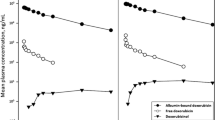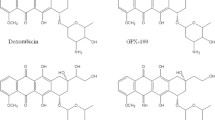Abstract
Lipophilic N-alkylanthracyclines such as AD 198 (N-benzyladriamycin-14-valerate) or AD 201 [N,N-di-(n-propyl)adriamycin-14-valerate], which exert their cytotoxicity through mechanisms which are not yet fully defined, possess inherent abilities to circumvent multidrug resistance in vitro and in vivo, possibly through alterations in normal intracellular drug trafficking. As part of structure-activity studies with this class of agent, we have now examined the pharmacology of AD 202 [N,N-di(n-butyl)adriamycin-14-valerate], another analog possessing superior antitumor activity to doxorubicin in vivo and an ability to circumvent multidrug resistance in vitro. Following the administration of AD 202 (20 mg/kg, i.v.) to anesthetized rats, rapid drug distribution (T1/2 5 min) was followed by more gradual elimination (T1/2 3.6 h). Plasma clearance of AD 202 (224 ± 63.6 ml/minper kg) and steady state volume of distribution (25.7 ± 11.1 I/kg) were indicative of extensive tissue sequestration and/or a large degree of extra-hepatic metabolism. The parent drug predominated in plasma until 20 min, thereafter N,N-di(n-butyl)adriamycin became the principal circulating anthracycline. The systemic exposure to this biotransformation product (area under the plasma concentration-time curve from time zero to 480 min AUC0-480 281672 ng-min/ml) was > tenfold higher than for the other detected plasma products (N-butyladriamycin-14-valerate, N-butyladriamycin, and three unidentified fluorescent signals; PI-3). Total urinary elimination over 8 h was limited (1.9% of dose), occurring predominantly as N,N-di(n-butyl)adriamycin (1.2% of dose), N-butyladriamycin (0.4% of dose), and their corresponding 13-carbinol metabolites (< 0.1% of dose each). Low levels of adriamycin (ADR), aglycones and two unidentified products were also seen. Parental AD 202 was found in urine only up to 1 h. By contrast, hepatic elimination of parent drug was seen, albeit at low levels, through 8 h. Excretion by this route (22% of dose) occurred principally as N-butyladriamycin (8% of dose), N-butyladriamycinol (2.1% of dose) with lower levels of N,N-di(n-butyl)adriamycin (1.6% of dose), N,N-di(n-butyl)adriamycin (0.8% of dose), and aglycones (4.3% of dose, combined). Other products included ADR (1.1% of dose) and two unidentified signals (3.4% of dose, combined). The relatively poor mass balance in these studies is attributed to prolonged intracellular retention (elimination T1/2 24.2 h) of N,N-di(n-butyl)adriamycin. Thus, in common with other N-alkylanthracyclines, the pharmacology of AD 202 is complex but its therapeutic properties clearly are not derived from an ADR prodrug effect. Significant differences continue to be noted as to the metabolic fate of congeners of this class of anthracycline analogs.
Similar content being viewed by others
References
Acton EM (1980) N-Alkylation of anthracyclines. In: Crooke ST, Reich SD (eds) Anthracyclines, current status and new developments. Academic Press, New York, p 15
Acton EM, Jensen RA, Peters JH (1982) Factors in the selection of new anthracyclines. In: Muggia FM, Young CW, Carter SK (eds) Anthracycline antibiotics in cancer therapy. Nijhoff, Boston, p. 205
Benet LZ, Galeazzi RL (1979) Noncompartmental determination of the steady state volume of distribution. J. Pharm Sci 68: 1071
Bodley A, Liu LF, Israel M, Seshadri R, Koseki Y, Giuliani FC, Silber R, Kirschenbaum S, Potmesil M (1989) DNA topoisomerase II interaction of doxorubicin and daunorubicin congeners with DNA. Cancer Res 49: 5969
Danks MK, Yalowich JC, Beck WT (1987) Atypical multiple drug resistance in a human leukemic cell line selected for resistance to teniposide. Cancer Res 47: 1297
Davies B, Morris T (1993) Physiological parameters in laboratory animals and humans. Pharm Res 10: 1093
French Epirubicin Study Group (1988) A prospective randomized phase III trial comparing combination chemotherapy with cyclophosphamide, fluorouracil and either doxorubicin or epirubicin. J Clin Oncol 6: 679
Ganapathi R, Grabowski D, Sweatman TW, Seshadri R, Israel M (1989) N-Benzyladriamycin-14-valerate versus progressively doxorubicin-resistant murine tumours: cellular pharmacology and characterisation of cross-resistance in vitro and in vivo. Br J Cancer 60: 819
Goldin A, Venditti JM, Geran R (1985) The effectiveness of the anthracycline analogue 4′ epi-adriamycin in the treatment of experimental tumors: a review. Invest New Drugs 3: 3
Israel M, Seshadri R (1986) N-Alkyl and N-benzyladriamycin derivatives. US Patent 4610 977, US Patent Office, Washington, DC
Israel M, Seshadri R, Koseki Y, Sweatman TW, Idriss JM (1987) Amelioration of adriamycin toxicity through modification of drug-DNA binding properties. Cancer Treat Rev 14: 163
Israel M, Sweatman TW, Seshadri R, Koseki Y (1989) Comparative uptake and retention of adriamycin and N-benzylad-riamycin-14-valerate in human leukemic lymphocyte cell cultures. Cancer Chemother Pharmacol 25: 177
Israel M, Koseki Y, Jenkins JJ (1991) Murine cardiotoxicity assay of the mechanistically novel adriamycin analogue, N-benzyladriamycin-14-valerate (AD 198). Proc Am Assoc Cancer Res 32: 423
Kalken CK van, Hoeven JJ van der, Jong J de, Giaccone G, Schuurhuis GJ, Maessen PA, Blokhuis WM, Vijgh WJ van der, Pinedo HM (1991) Bepridil in combination with anthracyclines to reverse anthracycline resistance in cancer patients. Eur J Cancer 27: 739
Krishan A, Sauerteig A, Gordon K, Swinkin C (1986) Flow cytometric monitoring of cellular anthracycline accumulation in murine leukemia cells. Cancer Res 46: 1768
Lameh J, Chuang LF, Israel M, Chuang RY (1988) Mechanistic studies on N-benzyladriamycin-14-valerate (AD 198), a highly lipophilic alkyl adriamycin analogue. Anticancer Res 8: 689
Lenaz L, Page JA (1976) Cardiotoxicity of adriamycin and related anthracyclines. Cancer Treat Rev 3: 111
Lothstein L, Sweatman TW, Dockter ME, Israel M (1992) Resistance to N-benzyladriamycin-14-valerate in mouse J774.2 cells: P-glycoprotein expression without reduced N-benzyladriamycin-14-valerate accumulation. Cancer Res 52: 3409
Maniar N, Krishan A, Israel M, Samy TSA (1988) Anthracyc-line-induced DNA breaks and resealing in doxorubicin-resistant murine leukemia P388 cells. Biochem Pharmacol 37: 1763
Ozols RF, Cunnion RE, Klecker RW Jr, Hamilton TC, Ostchega Y, Parrillo JE, Young RC (1987) Verapamil and adriamycin in the treatment of drug-resistant ovarian cancer patients. J Clin Oncol 5: 641
Peters JH, Ross G, Kashiwase D, Acton EM, Hunt A (1983) Metabolic disposition of N,N-dibenzyldaunorubicin in the rat. Cancer Res 43: 1477
Riggs E (1992) Antitumor antibiotics and related compounds. In: Perry MC (ed) The chemotherapy source book. Williams and Wilkins, Baltimore, p 318
Rowland M, Tozer TN (1980) Clinical pharmacokinetics, concepts and applications, Lea and Febiger, Philadelphia
Speyer JL, Green MD, Kramer E, Rey M, Sanger J, Ward C, Dubin N, Ferrans V, Stecy P, Zeleniuch-Jacquotte A, et al (1988) Protective effects of the bispiperazinedione ICRF-187 against doxorubicin-induced cardiac toxicity in women with advanced breast cancer. N Engl J Med 319: 745
Speyer JL, Green MD, Zeleniuch-Jacquotte A, Wernz JC, Rey M, Sanger J, Kramer E, Ferrans V, Hochster H, Meyers M, et al (1992) ICRF-187 permits longer treatment with doxorubicin in women with breast cancer. J Clin Oncol 10: 117
Sweatman TW, Ahmed NK, Israel M (1986) Relative activity of daunorubicin (DNR), adriamycin (ADR), and 4′epi-adriamycin (epiADR) with human liver reductases. Proc Am Assoc Cancer Res 27: 247
Sweatman TW, Seshadri R, Israel M (1989) Metabolism and elimination of N-benzyladriamycin-14-valerate (AD 198) in the rat. Proc Am Assoc Cancer Res 30: 619
Sweatman TW, Israel M, Seshadri R, Koseki Y, Beck WT (1990) Cytotoxicity and cellular pharmacology of N-benzylad-riamycin-14-valerate in mechanistically different multidrug-resistant human leukemic cells. J Cell Pharmacol 1: 96
Sweatman TW, Pawlik C, Seshadri R, Israel M (1991) Metabolism and elimination of N,N-di(n-propyl)adriamycin-14-valerate (AD 201) in the rat. Proc Am Assoc Cancer Res 32: 345
Sweatman TW, Seshadri R, Israel M (1992) Selective retention of N-benzyladriamycin-14-valerate (AD 198) in the lung following intravenous drug administration. Proc Am Assoc Cancer Res 33: 520
The Italian Multicentre Breast Study with Epirubicin (1988) Phase III randomized study of fluorouracil, epirubicin and cyclophosphamide vs. fluorouracil, doxorubicin and cyclophosphamide in advanced breast cancer: an Italian multicentre trial. J Clin Oncol 6: 976
Traganos F, Israel M, Seshadri R, Kirschenbaum S, Potmesil M (1985) Effect of new N-alkyl analogues of adriamycin on in vitro survival and cell-cycle progression. Cancer Res 45: 6273
Weenen H, Maanen JM van, Planque MM de, McVie JG, Pinedo HM (1984) Metabolism of 4′-modified analogues of doxorubicin. Unique glucuronidation pathway for 4′-epidoxorubicin. Eur J Cancer Clin Oncol 20: 919
Weiss RB (1992) The anthracyclines: will we ever find a better doxorubicin? Semin Oncol 19: 670
Author information
Authors and Affiliations
Corresponding author
Rights and permissions
About this article
Cite this article
Han, G., Israel, M., Seshadri, R. et al. Pharmacology of N,N-di(n-butyl)adriamycin-14-valerate in the rat. Cancer Chemother Pharmacol 37, 472–478 (1996). https://doi.org/10.1007/s002800050414
Received:
Accepted:
Issue Date:
DOI: https://doi.org/10.1007/s002800050414




